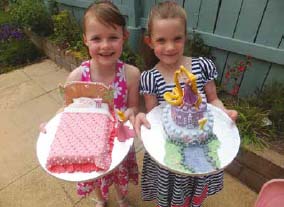9 September 2014
Twin mum Lucy Playford was wholehearted in supporting her daughters’ individuality, so why the pangs for their twin-ship as her efforts paid off ?
I read up as much as I could on twins before my own were born. Amidst all the practical advice and information, I was drawn to accounts of the emotional development within this unique relationship. I decided early on that, for our family, making sure our girls were known as individuals rather than ‘the twins’ was going to be important.
I endlessly corrected well-meaning relatives and friends, reiterating that my girls had a name each, Beth and Kate, that they would always like to have a birthday card of their very own, and that, in fact, they were two totally separate people who, even from an early age, liked different things. This was a revelation for some!
When dressing Beth and Kate, I took care to make sure they wore different clothes (people are still surprised to hear they each have their own set of knickers!). Their hair was styled differently; at school, one wears a pinafore and the other a skirt and jumper. This helped other people to tell them apart - I can't imagine how annoying and frustrating it must be for no one to know who you are.
At school, I was clear with teachers that Beth and Kate were to be treated as individuals, graded against their peer group and not each other, have separate parents’ evening slots and each be rewarded on their own merits. I chose to keep them in the same class at school as they each thrived in all areas being with each other.
At home, the girls were able to choose their own out-of-school activities (even though it meant double the to-ing and fro-ing), pick a story each at bedtime, and have their own shelves and cupboards for those personal, precious things that aren’t classed as ‘family toys’.

Now, as they hit the milestone of seven years old, I find I don’t have to do so much to support them as individuals - they are doing it all by themselves. And yet, whether it’s because I’m starting to have to let go of having such a big say in their lives, or the fact that I worry that their twin-ship is beginning to somehow diminish, I have to admit to finding it hard.
Recently, little things have started to change. Kate has been invited to a friend’s house on her own for the first time. Sometimes they don’t share a bedtime as Beth is out late at her gymnastics class. Kate is excelling in some areas at school, while Beth is in others. At playtime, Beth kicks a football around with the boys while Kate is happier chatting with a close friend.
I worry that their twin-ship is beginning to somehow diminish.
They are developing their own sense of style (if you could call it that!) when they choose clothes, which is always very different to each other.
Why I should be concerned by all this individuality after striving to encourage it for so long is a mystery to me. Perhaps it’s because as a parent you always hope your children will have great sibling relationships throughout their lives. And though I want my daughters to grow as individuals, I don’t want them to be any less close as siblings, or indeed as twins.
But then, as fate would have it, and just as I type these words, in comes Kate with a bedtime request: ‘Beth and I have found a book we both want to read, so is it okay if we read it together?’
Perhaps losing the twin bond should not be top of my list of things to worry about just yet.
-strap.svg)